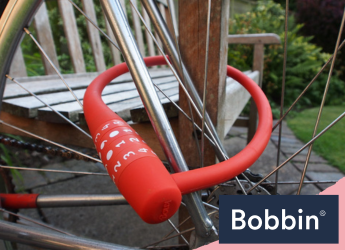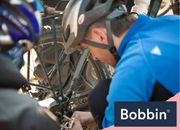How to Secure Your Bike with a Lock
Hello, fellow cyclists! Investing in your dream Bobbin bike is rewarding, but it sucks when it gets stolen. It can feel like a real kick in the guts, so we’re here to help. This guide covers the basics for securing your bicycle with a lock and keeping thieves at bay.
Learn to choose the right lock, master locking techniques, and find secure spots. Read on and ride confidently, ensuring your two-wheeled friend stays where you left it!
Choosing the Right Bike Lock
The first step to prevent getting your bike stolen is to have a lock that’s up to the task — in essence, a good one. Bicycle locks come in all shapes, sizes, and price points. As a general rule of thumb, quality comes at a price. More durable materials and designs cost more than their cheaper counterparts.
Say you plan to bolt your commuter bike overnight outside a city-centre train station. The type of lock you need will vary from someone fastening theirs to a table while having coffee nearby.
Various locks are available in the market, including cable and chain locks. A cable lock consists of intertwined metal cables with a lock mechanism at one end. It’s flexible, light, and versatile, making it easy to secure your bike to different structures. In contrast, a chain lock is made of metal links, offering strong theft protection. Both designs are looped around the Bobbin bicycle and secured. However, the latter option offers a higher level of cut resistance.
Choose based on your security needs and preferences for convenience. Tip: If you’re cycling with your little one, you might as well get them this cable kids bike lock.
Proper Locking Techniques

Your next move is to secure your bike properly, ensuring you do it tight every time. Here’s a step-by-step guide:
- Before starting, pick the appropriate lock for your situation. A cable lock is ideal for low-risk areas and quick stops or securing bike accessories. Meanwhile, a chain lock is recommended for high-risk spots, offering robust protection.
- Begin by locking the frame to a fixed object, such as a bike rack or post. Ensure the chosen object is immovable and securely anchored.
- For added security, loop the lock through both wheels and the frame. This prevents thieves from easily removing individual components.
- When securing your bike, position it in a way that reduces ground clearance. This makes it more challenging for potential thieves to use tools effectively.
- Before walking away, give the bike a gentle tug to confirm the lock’s firmness. This extra step ensures your bike is genuinely secure.
Common mistakes to avoid:
- Failing to secure all essential parts of your bike leaves it vulnerable. Always lock both wheels and the frame.
- Choose a lock that can go through the frame, wheels, and the fixed object without being too short.
- Avoid locking your bike in secluded or poorly lit areas. For one, these provide cover for theft attempts.
- Regularly check the condition of your lock. Make sure it functions correctly and is not compromised.
Follow these steps and avoid common mistakes to make your bike lock more effective.
Ideal Location for Locking Your Bike

When choosing secure bike parking locations, opt for well-lit places. The enhanced visibility is effective in deterring theft. You’ll also want to park it where there’s a constant flow of people. Take advantage of official bike racks when available - they are often placed in secure areas. Finally, select spots within view of security cameras to increase surveillance.
Red flag areas to avoid:
- Avoid parking in secluded areas with limited visibility. They provide cover for theft attempts.
- Steer clear of dark alleys or poorly illuminated areas. This can make it easier for thieves to go unnoticed and take even your kid’s balance bike!
- Avoid parking near structures that might be easily compromised or dismantled.
- Be cautious in areas with abandoned buildings or minimal foot traffic. These may attract unwanted attention.
Follow these tips to greatly lower the risk of bike theft and ensure your bike is in safe parking spots.
Round-up
Keeping your bike safe is a commitment for every rider. Choose a good lock, fasten it properly, and secure spots to enhance security. Avoid common mistakes, be careful in risky areas, and maintain your lock regularly. With these, you can safeguard your two wheels and contribute to a safer cycling community. Ride confidently, secure your bicycle, and enjoy the open road safely!
To secure bike baskets or double pannier bags, consider bike carrier straps. Up next on your reading list: How to Attach and Ride with a Rear Bike Basket








